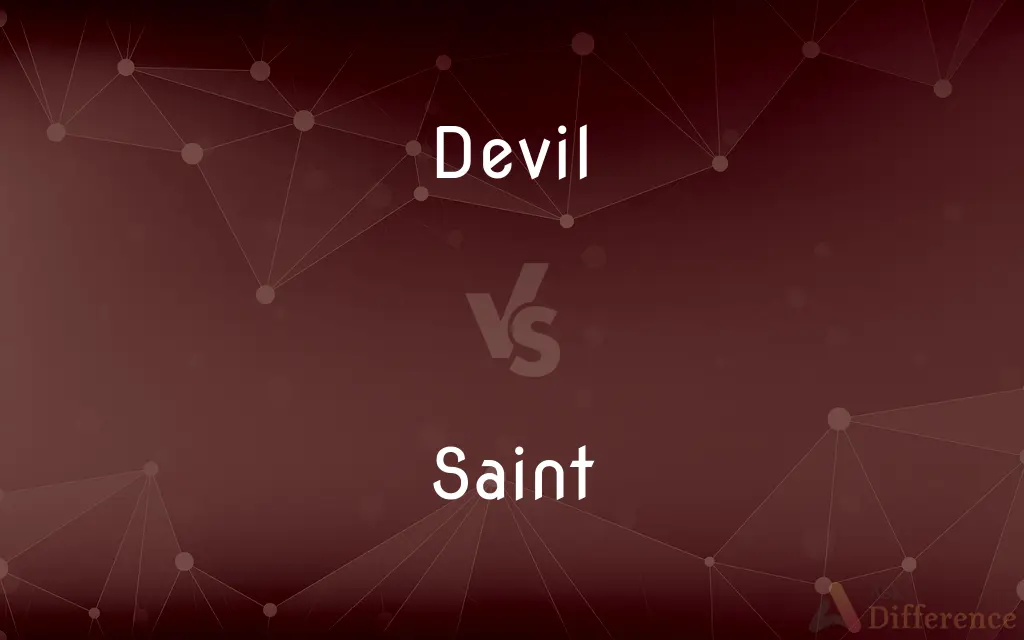Devil vs. Saint — What's the Difference?
Edited by Tayyaba Rehman — By Maham Liaqat — Updated on April 26, 2024
The devil is traditionally viewed as the epitome of evil and temptation in various religious contexts, often depicted as an antagonist to good, whereas a saint is considered a paragon of virtue and holiness, revered for their moral excellence.

Difference Between Devil and Saint
Table of Contents
ADVERTISEMENT
Key Differences
The devil, often referred to in Christian theology as Satan, embodies evil, chaos, and temptation. He is typically portrayed as a fallen angel who opposes God and exemplifies moral corruption. On the other hand, a saint is recognized for their exceptional fidelity to God and is often canonized after death by various religious institutions, especially in Christianity.
Devils are usually depicted in myths and religious texts as deceivers who mislead humans and encourage them to commit sins. Saints, conversely, are seen as moral guides who inspire people through their lives and deeds to live righteously and often intercede on behalf of others in spiritual matters.
In terms of influence, devils are believed to operate by promoting evil and suffering in the world, often seen as a spiritual adversary that individuals must resist. Saints, meanwhile, are considered protectors and exemplars, influencing people by example and sometimes attributed with performing miracles.
Culturally, the devil is often used symbolically to represent the darker side of human nature or the existential challenges people face. Saints, however, are celebrated and revered, with their lives and stories serving to uplift and teach virtues such as kindness, patience, and perseverance.
In popular culture, the devil appears in various forms, from a menacing figure in horror films to a metaphorical representation of temptation in literature. Saints also permeate cultural expressions but generally embody hope, resilience, and the triumph of spirit over adversity.
ADVERTISEMENT
Comparison Chart
Symbolism
Evil, temptation, chaos
Virtue, morality, holiness
Religious Role
Antagonist, deceiver
Exemplar, intercessor
Influence
Promotes sin and moral corruption
Inspires virtue and righteousness
Cultural Depiction
Often negative, as in horror and folklore
Positive, revered in stories and iconography
Common Beliefs
Opposes divine will, promotes suffering
Lives in accordance with divine will, revered
Compare with Definitions
Devil
Symbolizes temptation and moral corruption.
He resisted the devil's temptations to remain faithful to his morals.
Saint
A person acknowledged for their holiness and virtuous conduct.
She was canonized as a saint due to her selfless acts of charity.
Devil
Believed to influence individuals towards evil.
Legends often warn of the devil misleading people away from the right path.
Saint
Represents moral excellence and spiritual purity.
His life as a saint was marked by extreme humility and devotion.
Devil
A devil is the personification of evil as it is conceived in various cultures and religious traditions. It is seen as the objectification of a hostile and destructive force.It is difficult to specify a particular definition of any complexity that will cover all of the traditions, beyond that it is a manifestation of evil.
Saint
Often venerated and regarded as capable of interceding for the faithful.
The faithful prayed to the saint for protection and blessings.
Devil
Often Devil In many religions, the major personified spirit of evil, ruler of Hell, and foe of God. Used with the.
Saint
Frequently depicted as heroic figures in religious narratives.
Stories of the saint's miracles inspired many to follow her example.
Devil
A subordinate evil spirit; a demon.
Saint
Serves as a moral guide and inspiration in religious communities.
The teachings of the saint continue to influence the community's values and actions.
Devil
A wicked or malevolent person.
Saint
In religious belief, a saint is a person who is recognized as having an exceptional degree of holiness, likeness, or closeness to God. However, the use of the term "saint" depends on the context and denomination.
Devil
A person
A handsome devil.
The poor devil.
Saint
Abbr. St. or S. A person officially recognized, especially by canonization, as being entitled to public veneration and capable of interceding for people on earth.
Devil
An energetic, mischievous, daring, or clever person.
Saint
A person who has died and gone to heaven.
Devil
(Printing) A printer's devil.
Saint
Saint A member of any of various Christian groups, especially a Latter-Day Saint.
Devil
A device or machine, especially one having teeth or spikes and used for tearing.
Saint
A person who is venerated for holiness in a non-Christian religious tradition.
Devil
An outstanding example, especially of something difficult or bad
Has a devil of a temper.
Saint
An extremely virtuous person.
Devil
A severe reprimand or expression of anger
Gave me the devil for cutting class.
Saint
To name, recognize, or venerate as a saint.
Devil
(Informal) Used as an intensive
Who the devil do you think you are?.
Saint
To regard or venerate as extremely virtuous.
Devil
To season (food) heavily.
Saint
A person whom a church or another religious group has officially recognised as especially holy or godly; one eminent for piety and virtue.
Kateri Tekakwitha was proclaimed a saint.
Devil
To annoy, torment, or harass.
Saint
A person with positive qualities; one who does good.
Dorothy Day was a living saint.
Thanks for looking after the house while I'm away. You're a saint!
Devil
To tear up (cloth or rags) in a toothed machine.
Saint
One of the blessed in heaven.
Devil
(theology) The chief devil; Satan.
Saint
(archaic) A holy object.
Devil
(theology) An evil creature, the objectification of a hostile and destructive force.
Saint
(transitive) To canonize, to formally recognize someone as a saint.
Many wish to see Pope John Paul II sainted immediately.
Devil
(folklore) A fictional image of a man, usually red or orange in skin color; with a set of horns on his head, a pointed goatee and a long tail and carrying a pitchfork; that represents evil and portrayed to children in an effort to discourage bad behavior.
Saint
A person sanctified; a holy or godly person; one eminent for piety and virtue; any true Christian, as being redeemed and consecrated to God.
Them that are sanctified in Christ Jesus, called to be saints.
Devil
The bad part of the conscience; the opposite to the angel.
The devil in me wants to let him suffer.
Saint
One of the blessed in heaven.
Then shall thy saints, unmixed, and from the impureFar separate, circling thy holy mount,Unfeigned hallelujahs to thee sing.
Devil
A wicked or naughty person, or one who harbors reckless, spirited energy, especially in a mischievous way; usually said of a young child.
Those two kids are devils in a toy store.
Saint
One canonized by the church.
Devil
A thing that is awkward or difficult to understand or do.
That math problem was a devil.
Saint
To make a saint of; to enroll among the saints by an offical act, as of the pope; to canonize; to give the title or reputation of a saint to (some one).
A large hospital, erected by a shoemaker who has been beatified, though never sainted.
Whether the charmer sinner it or saint it.
Devil
Hell.
What in the devil is that?
What the devil is that?
She is having a devil of a time fixing it.
You can go to the devil for all I care.
Saint
To act or live as a saint.
Devil
A person, especially a man; used to express a particular opinion of him, usually in the phrases poor devil and lucky devil.
Saint
A person who has died and has been declared a saint by canonization
Devil
A printer's assistant.
Saint
Person of exceptional holiness
Devil
(India) A poltergeist that haunts printing works.
Saint
Model of excellence or perfection of a kind; one having no equal
Devil
A dust devil.
Saint
Hold sacred
Devil
A barren, unproductive and unused area.
Devil strip
Saint
In the Catholic church; declare (a dead person) to be a saint;
After he was shown to have performed a miracle, the priest was canonized
Devil
(cookery) A dish, as a bone with the meat, broiled and excessively peppered; a grill with Cayenne pepper.
Devil
A machine for tearing or cutting rags, cotton, etc.
Devil
A Tasmanian devil.
Devil
An endurance event where riders who fall behind are periodically eliminated.
Devil
(nautical) devil seam: {{ngd}}
Devil
To make like a devil; to invest with the character of a devil.
Devil
To annoy or bother.
Devil
To work as a ‘devil’; to work for a lawyer or writer without fee or recognition.
Devil
To prepare (food) with spices, making it spicy:
Devil
To grill with cayenne pepper; to season highly in cooking, as with pepper.
Devil
To finely grind cooked ham or other meat with spices and condiments.
Devil
To prepare a sidedish of shelled halved boiled eggs to whose extracted yolks are added condiments and spices, which mixture then is placed into the halved whites to be served.
She's going to devil four dozen eggs for the picnic.
Devil
The Evil One; Satan, represented as the tempter and spiritual of mankind.
[Jesus] being forty days tempted of the devil.
That old serpent, called the Devil, and Satan, which deceiveth the whole world.
Devil
An evil spirit; a demon.
A dumb man possessed with a devil.
Devil
A very wicked person; hence, any great evil.
Have not I chosen you twelve, and one of you is a devil?
Devil
An expletive of surprise, vexation, or emphasis, or, ironically, of negation.
The devil a puritan that he is, . . . but a timepleaser.
The things, we know, are neither rich nor rare,But wonder how the devil they got there.
Devil
A dish, as a bone with the meat, broiled and excessively peppered; a grill with Cayenne pepper.
Men and women busy in baking, broiling, roasting oysters, and preparing devils on the gridiron.
Devil
A machine for tearing or cutting rags, cotton, etc.
Devil
To make like a devil; to invest with the character of a devil.
Devil
To grill with Cayenne pepper; to season highly in cooking, as with pepper.
A deviled leg of turkey.
Devil
(Judeo-Christian and Islamic religions) chief spirit of evil and adversary of God; tempter of mankind; master of Hell
Devil
One of the evil spirits of traditional Jewish and Christian belief
Devil
A word used in exclamations of confusion;
What the devil
The deuce with it
The dickens you say
Devil
A rowdy or mischievous person (usually a young man);
He chased the young hellions out of his yard
Devil
A cruel wicked and inhuman person
Devil
Cause annoyance in; disturb, especially by minor irritations;
Mosquitoes buzzing in my ear really bothers me
It irritates me that she never closes the door after she leaves
Devil
Coat or stuff with a spicy paste;
Devilled eggs
Devil
A supernatural entity regarded as the embodiment of evil.
The story depicted the devil as a cunning trickster tempting humans.
Devil
Often represented as an antagonist in religious scriptures.
In many religions, the devil is seen as a constant adversary to the forces of good.
Devil
Appears in various cultural depictions, often villainous.
The play featured a devil character who embodied the darker traits of human nature.
Common Curiosities
Can someone be both a devil and a saint?
Traditionally, these terms are antithetical, representing opposite moral extremes in religious and cultural contexts.
Why is the devil often depicted with horns and a tail?
These features are symbolic, rooted in various cultural traditions to represent the devil’s malevolent nature.
What is the role of saints in religious practices?
Saints often serve as intermediaries, offering protection and guidance to believers who seek their intercession through prayer.
Are saints only found in Christianity?
While the formal concept of sainthood is most prominent in Christianity, similar figures exist in many religions, recognized for their spiritual excellence and moral virtues.
Are devils considered real beings in all religions?
Not all religions personify evil as a devil; some view evil more abstractly as behaviors or influences.
Is the concept of the devil unique to Western religions?
While the specific concept of the devil as Satan is mostly found in Christian theology, many religions have similar figures representing evil or chaos.
What lessons do tales of devils and saints teach?
Tales of devils warn against moral corruption and temptation, while stories of saints inspire people towards virtuous and righteous living.
Why do some people wear amulets or carry symbols of saints?
Many believe these items bring protection, blessings, or closer spiritual connections to the virtues embodied by the saints.
How does one become recognized as a saint?
In many religions, particularly Catholicism, becoming a saint involves a formal process of canonization, usually after performing miracles or martyrdom.
How do saints influence modern society?
Saints continue to influence modern society as symbols of virtues like kindness, courage, and faithfulness.
What historical events have impacted the veneration of saints?
Historical events, such as martyrdoms or miraculous occurrences, often enhance the veneration of saints by highlighting their spiritual strength.
What fundamentally distinguishes a devil from a saint?
The devil embodies the essence of evil and temptation, while a saint symbolizes virtue and moral integrity.
How do cultural perceptions of devils and saints vary across societies?
Cultural perceptions can vary widely, with devils often viewed negatively, while saints are universally respected and venerated.
Can devils be redeemed in religious texts?
In most religious narratives, devils are irredeemable, existing as perpetual embodiments of evil.
Do all cultures fear devils?
Fear of devils varies, with some cultures viewing them more as metaphors for internal struggles rather than as beings to be feared.
Share Your Discovery

Previous Comparison
Disaster vs. Catastrophe
Next Comparison
Ethics vs. EtiquetteAuthor Spotlight
Written by
Maham LiaqatEdited by
Tayyaba RehmanTayyaba Rehman is a distinguished writer, currently serving as a primary contributor to askdifference.com. As a researcher in semantics and etymology, Tayyaba's passion for the complexity of languages and their distinctions has found a perfect home on the platform. Tayyaba delves into the intricacies of language, distinguishing between commonly confused words and phrases, thereby providing clarity for readers worldwide.
















































